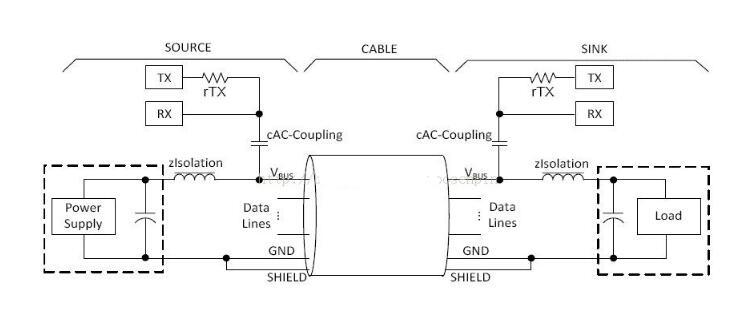It's a bit rude to say, but my answer may slap some other answers in the face.
Believe it or not, it doesn't matter. I welcome you to screen the information I give.
The size of the carrying current is not a problem of the interface protocol, but a physical problem.
1> Seeing someone say "Type-C has pins for PD protocol communication so it can be charged with PD protocol", I laughed again. There is no dedicated communication pin for PD protocol at all on type-C.
Tell everyone how the PD protocol implements the handshake. When the iPhone is plugged into the PD, there will be two "deng" beeps. The first beep is to charge and power up, and the second beep is to tell you that the PD handshake successfully starts 18w charging.

Looking at the picture, RX and TX send and receive carrier signals (FSK signals). The signals are sent from TX, coupled to the VBUS line through a cAC capacitor, and transmitted to the other end device. The capacitors are not separated, so the FSK signal can pass through the same cAC The capacitor reaches the RX end. The frequency of this FSK signal is 24MHz, which will be filtered out by the low-pass filter composed of the inductance zIsolation, so it will not affect the high level and will not interfere with the subsequent load circuit.
2>You said that the maximum current of the type-A interface is only 900mA, what about the type-A and type-C data cables?
The so-called maximum current of the USB3.0 type-A interface is only 900mA, but it is required to ensure that it can carry a peak load of 5V/900mA when powering devices that meet the USB3.0 protocol. This means that your main device must be able to provide such a large current, rather than the electrical equipment or data line that can only carry such a large current. That is to say, the external power supply of your computer interface cannot guarantee the power of 5V/900mA, and it cannot pass the USB3.0 standard. The power supply of the notebook USB3.0 interface is generally 1A or 1.5A, and there is no shortage of 2A or more.
How much current the data cable can withstand is only related to the thickness of the wire, and it doesn't matter how many pins the interface has. I think some people say that Type-C has four power supply pins, so each line is 1.25A, and the four lines are 5A-this statement is purely funny. Regardless of how many power supply pins you have, you only look at the cross-sectional area when it comes to the wire, and it is usually two V-G lines. After all, you only transmit power and do not need to make multiple strands like a headset fever.
Of course, it seems that the type-C interface Vbus has many contacts, but you can see how big the type-A reed is, and there is also a private customized version with enhanced materials. In fact, if you calculate the cross-sectional area of a lot of wires, you don’t really need to worry too much about the interface contacts. The current-carrying limit difference caused by the aging of the optical contact and the tightness of the pressure is much larger than the current-carrying value of the current general wire.
The industry practice is that the high-current wire must pass the relevant standards, and the single PD requires a special high-current master control, including the wire also requires chip certification. Special chips are needed because the PD protocol not only supports high power, but also multi-voltage standards. Obviously, the currents are different under 5V, 12V, and 20V. In order to ensure that wire manufacturers do not mess around with JB, the USB-IF Association gives high An E-Marker certification chip was built for the 3A transmission cable, similar to Apple's MFI. If your type-C interface power supply circuit does not support PD, the voltage is locked and even the chip is not needed.
In the micro USB era, many mobile phone manufacturers have long achieved a type-A interface power supply of more than 900mA, whether it is 5V/4A or 9V/3A, and basically just pull the cord and use it.
In the type-C era, because the mainstream of high-power power supply adopts the PD protocol, as mentioned earlier, PD is a variety of voltage standards. Although the power upper limit may be unified, the USB-IF Association still uses the current as the limit, and requires the specified chip for the high current range. And specifications of wire. Type-C can be as high as 100W (20v/5A) and 65W (20v/3.25A). The essence is that the wire is thick enough
In order to save wires, many manufacturers have developed 61W and 20.5v power supply "personal standards" in order to save wires, including E-Marker certification chips. The purpose is to keep the current within 3A.
Pay special attention, no matter what tricks the manufacturer plays, you should pay attention to whether there is an E-Marker protocol when buying cables. It does not support power supply above 3A. Otherwise, even if you plug in a 100W power supply, the power can only reach 60w (20v/3A) .
So it is not simply that the maximum current of type-C is larger than type-A.
But only if the wire is thick enough, its current can be large.
Type-C cables that do not require certification can easily transmit currents below 3A, and this is the same for type-A.
You can make the type-A cable the same standard as the type-C cable that meets the maximum 5A certified by E-Marker. It is not impossible to build a 5A power supply circuit yourself. Of course, the USB-IF Association will not give it. Certification is another matter.
USB 3.1 SuperSpeed USB C Cable
USB 3.1 Type-C Dual Screw Locking Down Up Angled to Standard USB3.0 Data Cable 90 Degree for Camera
Send your message to us:
Post time: Apr-06-2021